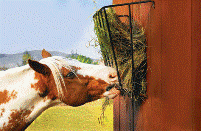Mycotoxins in German horse feeds

German research showed that many horse feeds are contaminated with mycotoxins, although most levels found were below levels that are dangerous to horses.
Researchers from the Justus Liebig University in Giessen and the Ludwig Maximilians University in Oberschleissheim, both in Germany, have sampled 62 commercial horse feeds containing cereal mixtures and plain horse feed grains from the German market.
All samples were analysed for six different mycotoxins (mycotoxin groups): deoxynivalenol (DON), zearalenone (ZEA), fumonisin B1 (FB1), T-2 toxin (T-2), sum of T-2 + HT-2 toxin (T-2/HT2), ochratoxin A (OTA), and total ergot alkaloids (GEA).
All samples contained DON, T-2/HT-2 , and T-2. ZEA was detected in 98% of the samples. Most samples (94%) were positive for FB1. Ergot alkaloids were detected in 61% of samples, and OTA was found in 42% of samples.
Co-contamination is common
The results demonstrate that a co-contamination with several mycotoxins is very common in commercial horse feed from the German market.
The toxin concentrations were in most cases well below the levels which are usually considered as critical or even toxic.
The highest mycotoxin concentrations were mostly found in single-grain cereal feed: the maximum values for DON and FB1 were found in maize, the highest T-2/HT-2 toxin concentrations were found in oats, and the highest concentration of ergot alkaloids was found in barley.
In composed feeds, no correlation between cereal composition and mycotoxin levels could be found.
The full article can be read in BioScience Technology(registration required)











